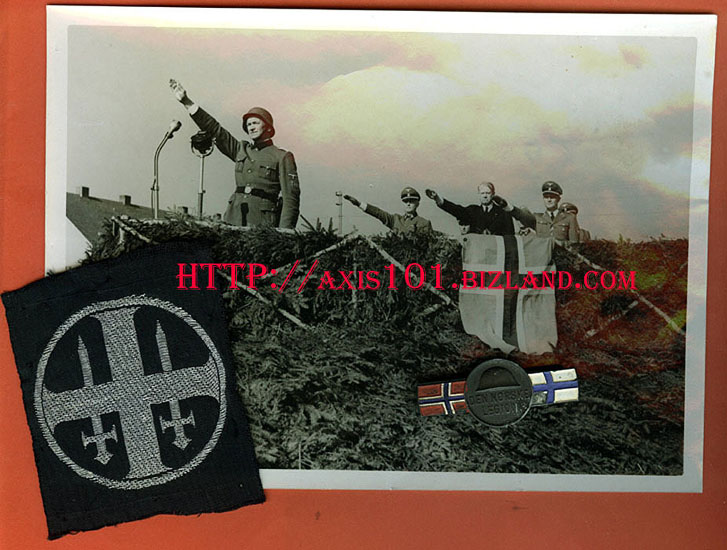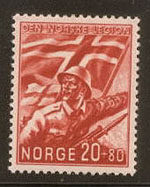|
In 1933, a Norwegian
pro-Nazi party was instituted by Vidkun Quisling and was called the "NASJONAL SAMLING"
(National Unity). In April 1940, Germany invaded the Norwegian coastlines because Hitler
feared that the British fleet would invade Norway's vital strategic seaports and take
control of its natural iron resources. During the German occupation of Norway, the
pro-Nazi Party under Quisling's leadership actively supported the Germans. There was a
Norwegian interest in forming an expeditionary force to fight along side the Finnish against
the Soviets. With German support represented by Reichskommissar Josef Terboven, the pro-nazi
party called for a meeting of four high officials of the Norwegian Army to create a legion.
A massive recruiting rally was held on the University Square in Oslo on 4 July 1941.
It is interesting to note that the Norwegian Post Office assisted the enlistment drive by issuing
a semi-postal stamp on 1 August 1941.
Notice the Norwegian Legionnaire wearing the royal uniform,
on his left arm is an emblem showing "the cross of Saint Olaf," the symbol used by members
of the Quisling party. In the background are both the Norwegian and Finnish flags. The propaganda
value was to encourage political members to enlist in the Finnish forces;
however, most volunteers
ended up joining the Waffen-SS. (for more info. go to my Legion Stamp page).
The Norwegian Government intended to form a full regiment
of two battalions but due to strict admissions standards and brief six terms of enlistment only
one battalion was realized. They were to be titled "Gula" and "Frosta" (later the named for the
1st battalion was changed to VIKEN, the other battalion was never formed). The Legion was sent
to Bjolsen Skole camp in Norway where uniforms were received. The Legionnaires were surprised
to receive German SS uniforms since they had expected to wear Norwegian or Finnish uniforms.
The only difference was the Norwegian national flag sleeve patch, which was worn on SS uniforms for a very
short time. Many volunteers were already wearing locally made collar tabs with the Norwegian emblem made
of metal or embroidered. In addition, some volunteers wore the locally made "Dens Norke Legion" cuff title.

Interesting press photo showing a contingent of Norwegian volunteers marching in Oslo in front of the castle where Quisling resided, and just before leaving towards the training camp in Fallingbostel and so on to the Eastern Front.
On 29 July 1941, the first 300 Norwegian volunteers arrived in Kiel, Germany, and were sent to
Fallingbostel Training Camp. By August 1941 the total number of recruits had grown to over 700.
By the end of 1941, it had the strength of 1218 men with an additional reserve battalion provided
for replacement. The officers were sent to Lauenburg training camp. 
Norwegian Legion Cuff Title
On top you'll see an enlisted RZM pattern Norwegian Legion Cuff Title.
The information found on
many books indicating that another cuffband existed with the inscription "Legion Norwegen" are incorrect.
According to my Norwegian colleague Bjørn Jervas, many Norwegians opted in removing the
"Freiw." from the cuffband in order to rename it "Legion Norwegen." The Norwegian Legion on the Eastern Front The Legion was commanded respectfully by Major Jorgen Bakke and Major Finn
Kjelstrup (both ex-Norwegian Officers) however both officers resigned in early December 1941. In
December 1941, after completing six months enlistment, Legionnaires re-enlisted for another six
months. Originally the plan was to have them serve in the Finnish sector of the Eastern Front but
because of the critical situations elsewhere in Russia, the Legion was transported by train to the Leningrad Front.
This Legion had no contacts with their compatriots in the Wiking Division who were considered full
Waffen-SS cadre personnel. 
Norwegian Legion SS HIRD insignia Above is a picture illustrating SS-Sturmbannführer Major Jorgen Bakke commander of
the "Den Norske Legion" and in the background is SS-Brigaderführer Wagner, Vidkun Quisling and Reichskommissar Terboven near the Fallingbostel Training Camp. | |||

Norwegian SS Polizei Collar Tab Very rare Norwegian collar tab worn by members of the Police SS Companies. The Norwegian Police Companies wore both lion collar tabs. The white crowned lion insignia is made of zinc.
| 
Norwegian Recruiting Propaganda Leaflet
Recruiting propaganda leaflet for the SS-Regiment Norge.
I was fortunate to have the leaflet translated by my
good friend Erik. I have only provided a partial translation of the propaganda
leaflet.
ALARM!
SS-Kriegsberichter Fritz Ihlen

|
